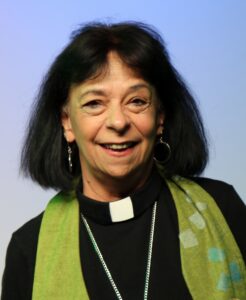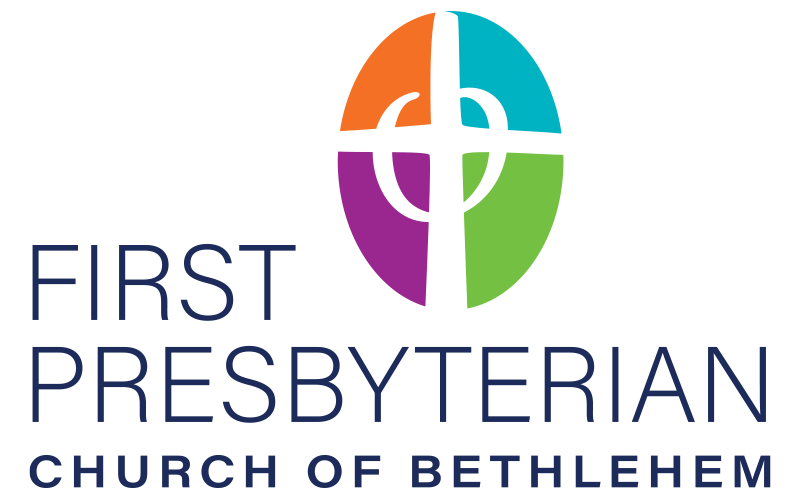The Rev. Santana-Grace is a former Associate Pastor at First Presbyterian Church of Bethlehem, and is current Co-Moderator of PC(USA)’s General Assembly.
“The light shines in the darkness, and the darkness did not overtake it.” This verse has become fundamental in my identity as a follower of Jesus. Years ago, about the time I began serving here, I also worked with the Waldensians – Christians born in the late 1100s (today primarily in Italy, Argentina and Uruguay). This was and continues to be their motto – in their historic struggle for religious freedom and today – in their solidarity and commitment to stand for the religious freedom of others – “The Light shines in the darkness. ”
These words have accompanied me through the seasons  of my life – the loss of an infant child; the death of my parents; the disappointments that are woven through my life. These words – the light shining in the darkness have compelled me to not surrender to the dark shadows of pain, fear and loss that are part of our earthly pilgrimage.
of my life – the loss of an infant child; the death of my parents; the disappointments that are woven through my life. These words – the light shining in the darkness have compelled me to not surrender to the dark shadows of pain, fear and loss that are part of our earthly pilgrimage.
I’m continually moved by the image of God’s light breaking into the darkness – revealing God’s love not only to a few faithful – but to the world – so that all might experience God’s grace and hope. I am moved by a God who finds a way to break through the shadows – affording us the possibility to see what is unseen; providing vision when there seems to be none – especially in times where darkness seems to prevail in injustice, violence, war – overwhelming our capacity to experience any kind of hope. The light shine in the darkness.
Over the years I’ve come to picture that light differently from the white lights portrayed in paintings. I imagine God’s light breaking in upon us – more like the northern lights, the aurora borealis – dancing, moving, whispering, singing into the darkness – unable to be contained.
Not long before the global pandemic, our son Dakota sent us to Iceland for our 30th anniversary. What an extraordinary experience. While there – on the southeast coast of Iceland, the hotel phone rang at 11 p.m. – telling us the northern lights were “out.” We rushed to the rooftop terrace, where for more than an hour we stood in silence – staring at the green and bluish lights gently pulsating in the sky. My camera didn’t work – I remember trying to memorize the movements. There was something sacred about that moment – making me aware of God’s profound presence.
That trip – along with others, have afforded me with unexpected experiences that have left my soul with a profound sense of peace and awareness of God’s presence. This past September, I had the opportunity to visit island nations in the middle of the Pacific Ocean – or the Pasifika as it is called by its inhabitants. I was not prepared for its majesty and beauty. Notwithstanding the challenges facing the nations of Kiribati, Fiji and the Marshall Islands, (and there are many – rising sea levels causing a forced migration and diaspora that is threatening the historic identity of a rich heritage). Yet notwithstanding this painful reality, the colors of the sea coupled with the spirits of the people – were extraordinary, causing a deep stirring in me – making me aware of God’s presence – leaving me speechless. Perhaps you’ve experienced moments like this – in the beauty of the mountains of PA or the surrounding states.
These are places so precious; moments when words just don’t reach, causing our souls to stir. They remind me of an ancient Celtic understanding known as “thin places.” According to Celtic tradition “heaven and earth are only 3 feet apart – but in the thin places the distance is shorter still.” I love this imagery lifting up the spaces where heaven and earth meet – where humanity encounters the divine.
New York Times Travel columnist Eric Weiner defines “thin places” as “those rare places or spaces where the distance between heaven and earth collapses and we’re able to catch glimpses of the divine.” In essence, a veil is lifted and we experience God in a way we’ve not known before – very often leaving us with a transformational choice – either to respond to the divine, affirming to whom we belong – or to let the moment slip away.
For us as a people of faith, the sacraments of baptism and Holy Communion are considered ‘thin places’ – where that veil is lifted making known the divinity of Jesus to the world, connecting us to the risen Christ. Theologian Frederick Buechner says that a sacrament… is “…a transparent time, a time which you can see through to something deep inside… where you are apt to catch a glimpse of the almost unbearable preciousness and mystery of life.” When have you experienced the almost unbearable preciousness and mystery of life?
Clearly the Biblical witness is rich with moments where humanity encounters God – thin spaces that are at once both disorienting and transformative. The Exodus journey – God on Mt. Sinai, the pillar and cloud guiding a people in the wilderness. And of course – in this season of advent – we are mindful of the ultimate moment when heaven and earth meet – in the incarnation of the Christ child.
Thin places however are not limited to geography or even the Biblical witness. They can also be spiritual and relational – but with one thing in common. Whenever these encounters occur – whenever heaven and earth meet, God’s presence breaks through – jolting us out of wherever it is we find ourselves – calling us into a new depth of understanding – compelling us to ask ourselves – what will we do with this divine encounter? Will it be but a moment in our lives or will it cause a movement of transformation possibilities in how we live?
Thin places are a sacred gift. But thin places – physical or spiritual – are not always easy to identify nor engage. Our access to thin places can be compromised by the all-too- common thick places – within and around us. We could say we live between the thick and the thin – a liminal space – making it difficult for God’s presence to be revealed to us. As the Church of Jesus Christ considers its role and relevance for a time such as this, it’s critical we reflect on some of those thick places that don’t allow us to be transformed or serve as agents of transformation in this world. Advent – this season when we are once again making our way to the manger – seems a perfect time to consider what gets in our way of experiencing God.
One common thick place is – the thick place of our assumptions. Now assumptions are not all bad. On the positive side, assumptions help ground our identity. However they become a problem when they become idols of sorts. Perhaps you have heard yourself say, “We know what we know – so what we know must be true.” A well-known American actor said “assumptions are the termites of relationships.” Quite the image! Unfortunately, these termites of assumptions frame much of our cultural conversations today. We no longer come from a place of dialogue. Instead we are convinced “I am right – so you must be wrong.” The truth is that after working with more than 150 congregations, I’ve come to believe that “being right is over-rated”.
There is a danger when we hang on to being right – a danger that compromises the life not only of our most intimate relationships, but of the community. I remind myself that Jesus was crucified because both the political and religious powers believed they were right.
Between thick and thin – the challenge of breaking through the blinding veil of our assumptions.
A second thick place that gets in our way of thin places is the thick place of our fears and anxieties. There is a reason the Bible offers us more verses about “fear not” than any other phrase. Fear, like a tsunami, is a powerful stimulus of reactivity, paralysis of action and isolation. Dr. Martin Luther King, Jr. said that we must build dykes of courage to hold back the flood of fear. When you and I make decisions out of fear, we can easily take actions that don’t allow for possibilities. When we allow our fear to frame our actions, we cheat ourselves from discovering God in our midst.
Overcoming our fears move us toward that thin place where heaven and earth touch in time, where we are invited to experience a glimpse of the kingdom of God on earth – as it is in heaven. Between thick and thin – the challenge of breaking through the blinding veil of our fears.
These two thick places, along with other thick places you can surely name (such as denial or blame) blind us to the seemingly impossible possibilities that God has before us. They limit our ability to encounter God – whether in the thin places of nature, worship, music, relationships, and more.
Clearly thin places do not require a trip to any extraordinary physical space – but they do require allowing ourselves to journey into new spiritual spaces – as open vessels – with our hearts and our minds. I leave you with the words of a poet… A ”thin place is an encouragement, a sacred invitation to draw near, to approach barefoot, in humility, in reverence and awe…”
So as you continue your pilgrimage to the manger this year – as you approach the infant child in humility and awe – may you resist the assumptions and fears that tempt you into the shadows. May your heart be open to those thin spaces where the divine encounters your humanity. May those encounters not simply be confined to a moment that lives in your memory (or that you take out of boxes once a year), but compels your soul toward a life-long movement – that mirrors the sounds and colors of the aurora borealis – deepening your awareness of the Creator – as you seek to faithfully embody the teachings of Jesus in this world – teachings of justice, mercy and love.
My siblings, there is no question. There is much darkness around us. But be encouraged! “The light shines in the darkness” – and the darkness has not, does not, and will not overcome it.
